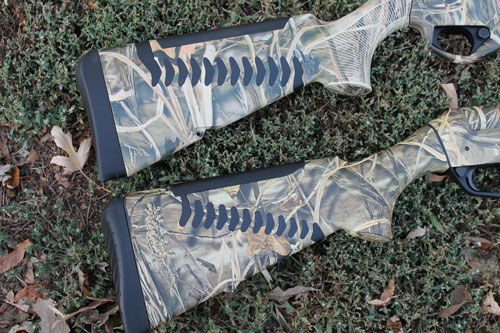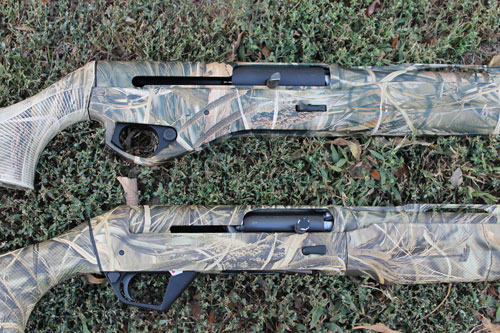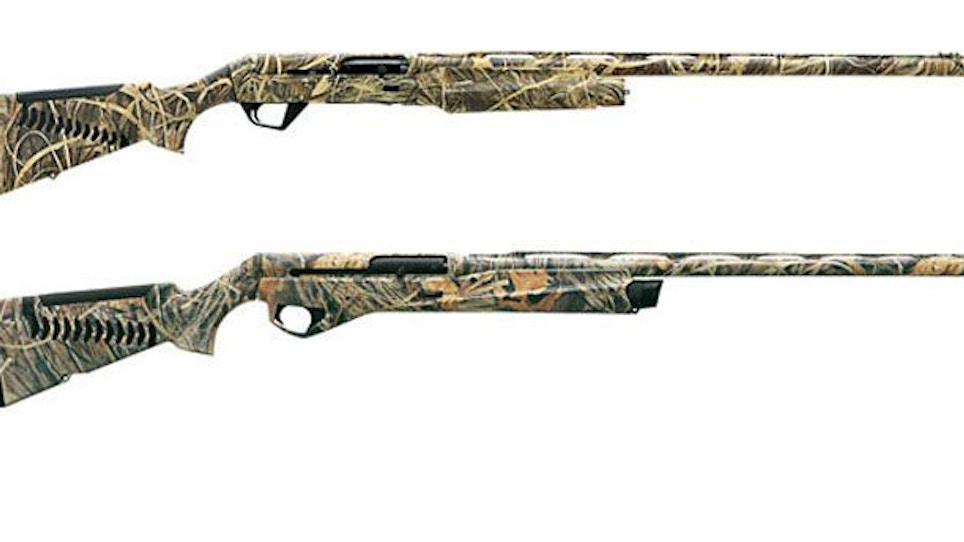 It’s no secret Benellis are massively popular in the waterfowling shotgun world, and for good reason. They have a well-deserved reputation for reliability and ruggedness.
It’s no secret Benellis are massively popular in the waterfowling shotgun world, and for good reason. They have a well-deserved reputation for reliability and ruggedness.
For two decades, the Super Black Eagle has been Benelli’s flagship semi-auto. As the first autoloader chambered for 3½-inch 12-gauge magnums, the original SBE and updated SBE II have been perennial mainstays in marshes and goose pits for over a generation.
However, the recent introduction of the 3½-inch Super Vinci threatened to challenge the SBE II’s dominance, leaving many waterfowlers wondering which one they should buy.
What follows is a side by side comparison of these two fine shotguns. Test guns were a loaner SBE II and my personal Super Vinci. Although the SBE II was the tricked-out Performance Shop Waterfowl Edition, the Super Vinci held its own. While similar in many ways, both guns have some distinctly unique attributes.
Let’s start with the stock. The SBE II has the standard, recoil-absorbing ComforTech stock, while the Super Vinci has a ComforTech Plus stock. Both feature 12 recoil-absorbing chevrons, but the ComforTech Plus chevrons are larger. Both guns also have beveled recoil pads that fit nicely into the shoulder pocket, but the SBE II has an ultra-soft gel pad, while the Super Vinci’s ComforTech Plus pad is made of firmer rubber. Likewise, the SBE II has a softer gel cheek insert than the Super Vinci. I’d give a slight nod to the SBE II for the softer pad and cheek insert.

The checkering on the SBE II is rounded AirTouch dimpling, while the Super Vinci has aggressive grooves. Both are effective, but the AirTouch checkering provides a bit more bite. The guns have differently molded forearms, but the Super Vinci’s seems more ergonomic to me — but that’s subjective.
My Super Vinci’s trigger is still pretty stiff, even after a couple seasons of use. The Performance Shop SBE II’s trigger was honed and ultra-crisp, giving it the edge in this instance, but such might not be the case with a standard SBE II.
Both have large trigger guards that accommodate heavy gloves, and each trigger group features easy, one-pin removal for cleaning. On camo models, the modular Super Vinci’s integrated trigger guard is fully camouflaged, while it’s black on the SBE II.

The SBE II has a large, triangular safety located conveniently behind the trigger. The Super Vinci has an equally large, round safety, but it’s located in front of the trigger. This will be a sticking point for many, including myself. I have to give two big thumbs up here to the SBE II for having its safety where — in my opinion — God intended a shotgun’s safety to be. The Super Vinci’s forward-mounted safety really bothers me, although it’s admittedly probably more of a mental block than a real problem. Those used to front-mounted safeties, as on Winchester pumps and Beretta semi-autos, will likely do just fine with the Super Vinci. Even so, I still wish it was behind the trigger, which also happens to be the most common complaint Benelli hears about this gun.
The bolt handle was oversized on the Performance Shop SBE II, but the Super Vinci’s is also large, so that’s a draw. The SBE II’s enlarged bolt release button was slightly easier to use. The SBE II’s bolt holdback button is located on the right side of the trigger guard, while the Super Vinci’s is centrally and conveniently located in front of the trigger guard where it can be easily reached with either hand.
Both guns have integrated sling attachments. The sling stud on the SBE II’s magazine cap swivels, but the sling hardware scratches the cap’s camo finish, due to the cap’s design. The Super Vinci’s integrated sling attachment doesn’t swivel, but it doesn’t damage the finish, either.
All Benelli semi-autos are powered by the proven Inertia Driven operating system. The SBE II’s recoil spring that compresses during the cycling process is located in the stock. All moving parts of the Super Vinci’s new In-Line Inertia Driven system are located within the receiver. With no parts in the stock or straddling the magazine tube, the gun balances squarely between the hands. In my opinion, the In-Line system is also slightly softer shooting than the standard Inertia Driven system, especially with high-velocity magnums.
The SBE II Waterfowl model features Max-4 camo and a 28-inch barrel with a lengthened and polished forcing cone. My Super Vinci, also in Max-4, has a standard 26-inch barrel, but a 28-inch barrel and other finishes are available.
The SBE II has a raised vent rib that sits flush with the receiver. The Super Vinci also has a raised vent rib, but there’s a gap between the receiver and rib, and the resulting sharp edge can cut into your hand when carrying the gun. Why the rib doesn’t extend all the way back to the receiver is beyond me.
The Performance Shop SBE II comes with a Hi-Viz front sight. A green one was installed, but seven light pipe options are included — two green, two white, and three red. The Super Vinci has a red bar front sight. Both guns have steel mid-beads.
The SBE II Waterfowl model boasts a set of Rob Roberts’ excellent Triple Threat extended waterfowl chokes — T1 for close range, T2 for mid-range, and T3 for pass-shooting. My Super Vinci came with the factory set of five flush-mount chokes, but I also had on hand a set of Triple Threat tubes for it. When shooting doves, I used a T1 in the SBE II, which worked well on close to medium range birds, and a T2 in the Super Vinci, which performed better at medium to longer yardages.
Both guns reliably cycle 1 1/8-oz. and even some 1-oz. loads up to the heaviest super magnums, although lower-velocity rounds gave each trouble.
Regarding takedown, either for transport or cleaning, the modular Super Vinci is the clear winner. It quickly breaks down into three main components — stock, barrel/receiver, and trigger group/forearm.
 As for other amenities, each model comes with a hard case. The SBE II’s is larger, but the compact, rectangular shape of the Super Vinci case easily fits into a pickup’s tool box or behind a backseat. Both guns also have shim kits for adjusting drop and cast. I installed the lowest, right cast shim on my Super Vinci for proper alignment. The one already installed on the SBE II loaner suited me just fine, so I left it alone.
As for other amenities, each model comes with a hard case. The SBE II’s is larger, but the compact, rectangular shape of the Super Vinci case easily fits into a pickup’s tool box or behind a backseat. Both guns also have shim kits for adjusting drop and cast. I installed the lowest, right cast shim on my Super Vinci for proper alignment. The one already installed on the SBE II loaner suited me just fine, so I left it alone.
So, who’s the winner? I probably shot the SBE II a little better, and the Performance Shop enhancements were certainly nice. However, the Super Vinci’s slightly softer-shooting (my opinion) In-Line inertia system balances the gun nicely and makes shooting heavy loads less punishing. Still, that front-mounted safety bugs me, which is probably why I shot the SBE II, with its properly placed safety (again, my opinion), better. Even so, I own a Super Vinci, but returned the SBE II at the end of testing. While the Performance Shop model costs more, a standard SBE II is priced similarly to a Super Vinci. Ultimately, it boils down to a matter of personal preference. Both are tough, dependable, workhorse semi-auto scatterguns.






